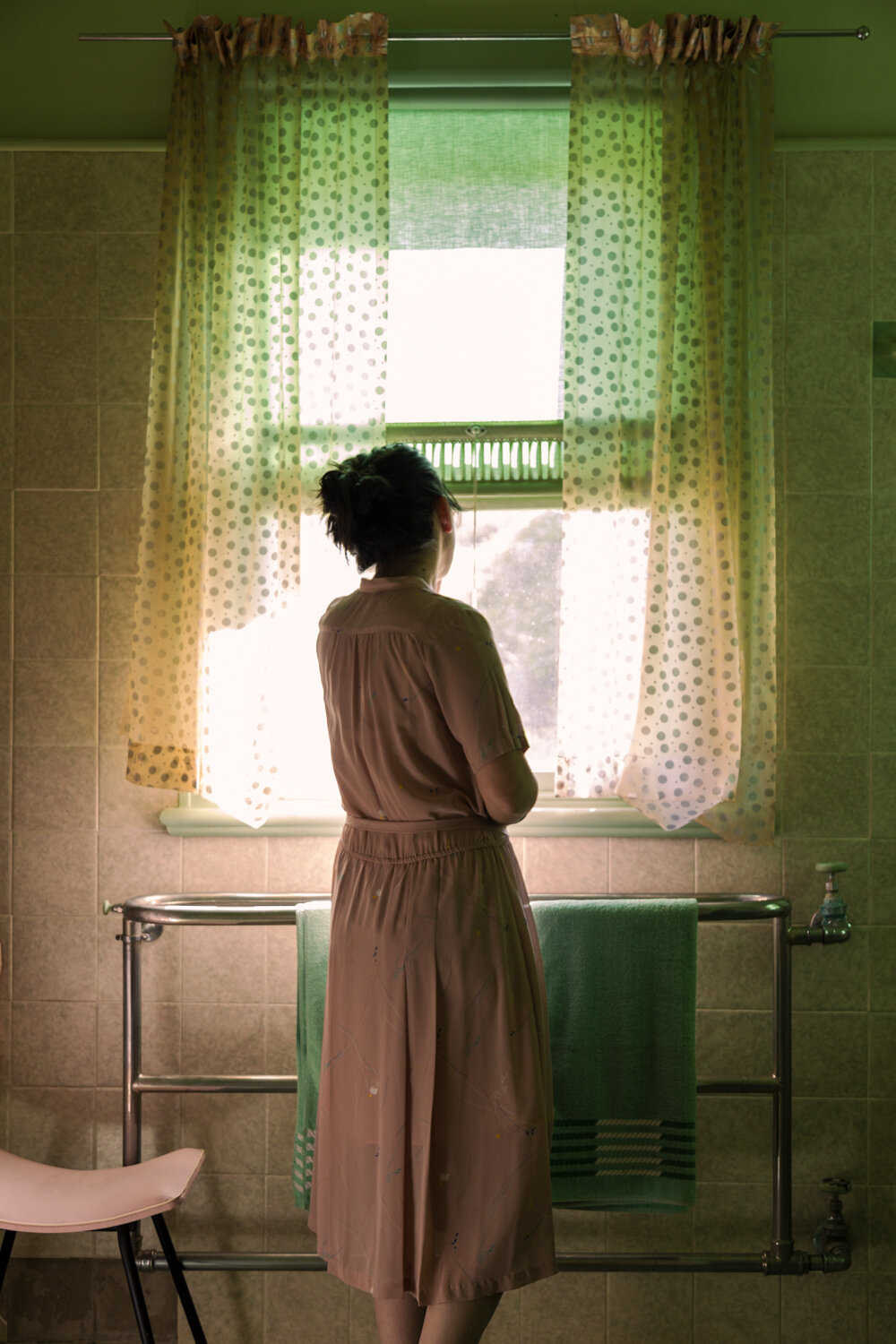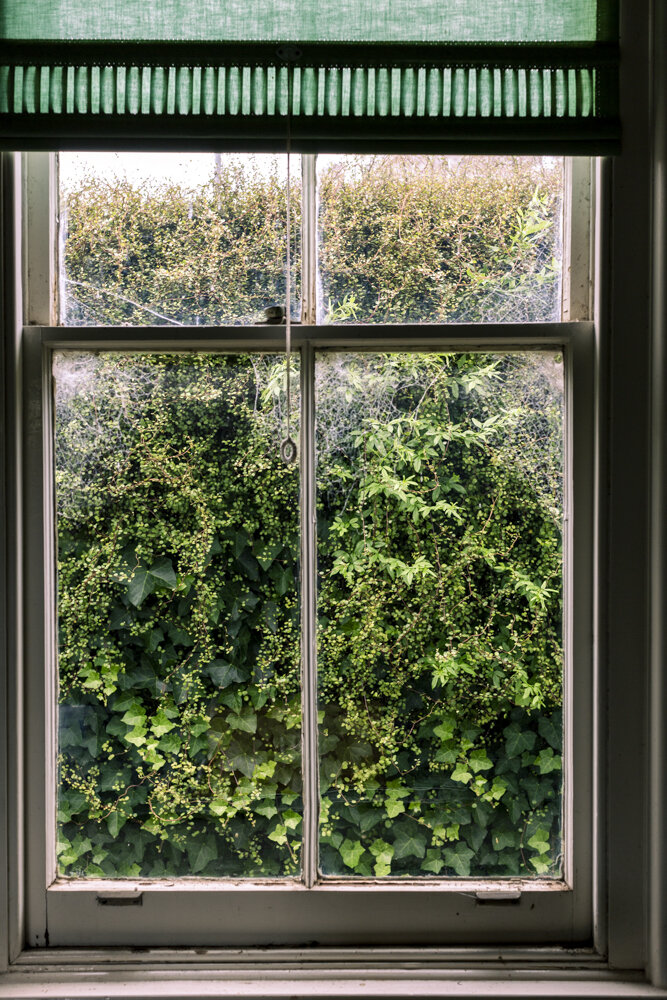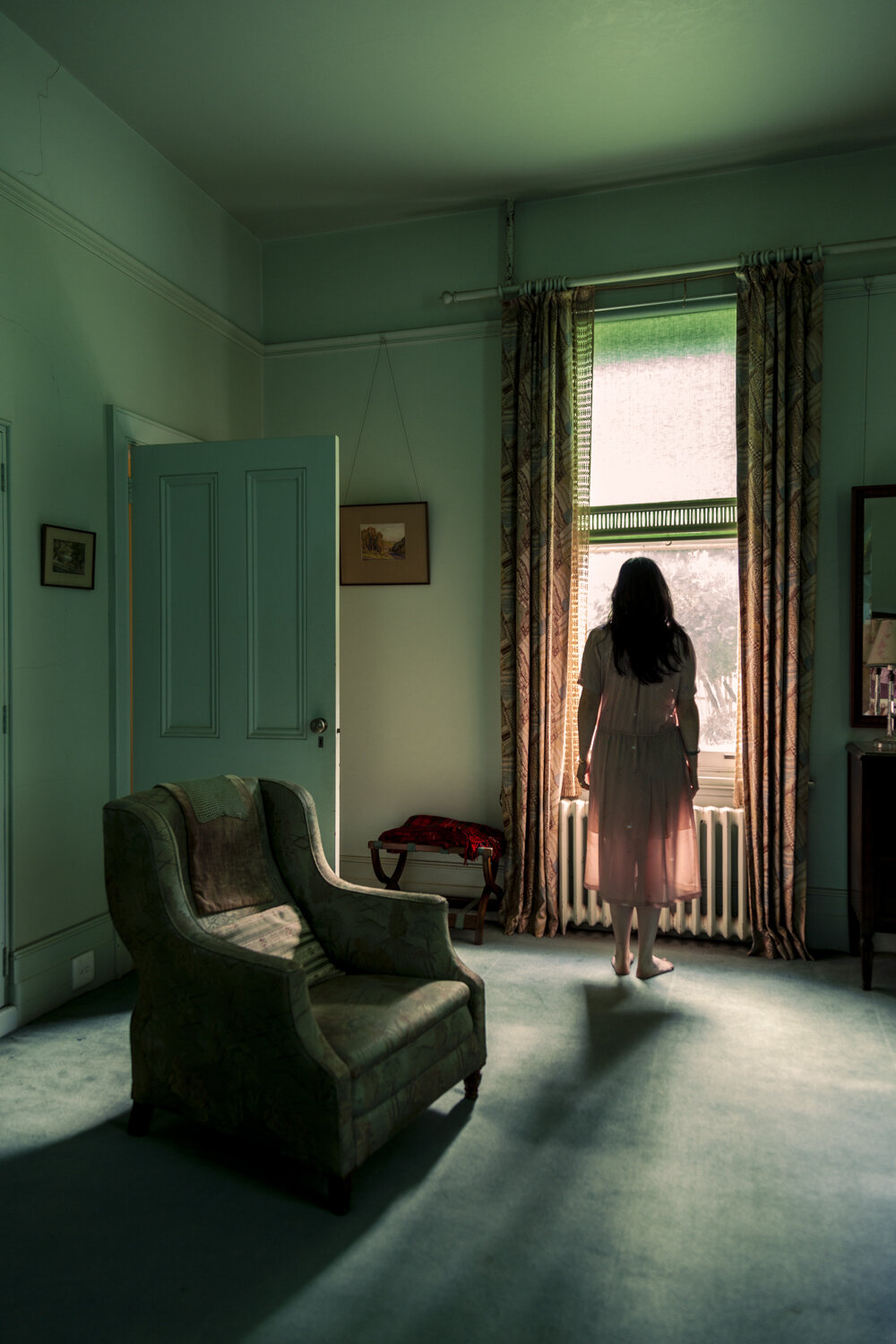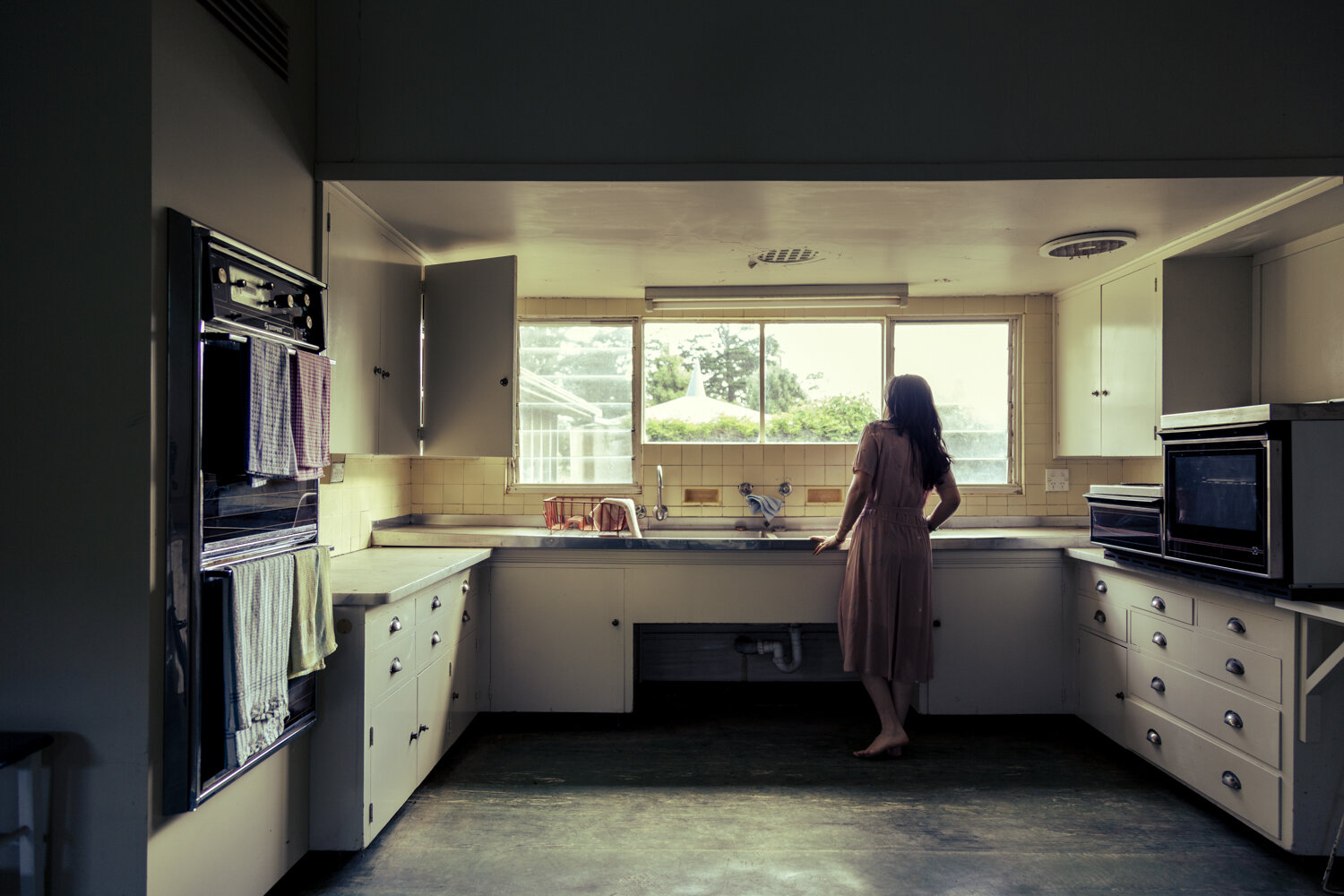FAINT ECHOES : PIA JOHNSON
BUNDOORA HOMESTEAD EXHIBITION 9 JULY - 17 SEPTEMBER 2022
Pia Johnson is known for her distinctive portraiture and performance photography. For a new exhibition at Bundoora Homestead Art Centre, the artist turns to the self as subject matter, employing self-portraiture to examine transcultural identity, place, memory and belonging. Pia’s line of inquiry centres on the histories of representation of the Eurasian female body in domestic settings, and Faint Echoes forms part of the artist’s ongoing considerations of post-colonial and feminist narratives in contemporary Australia as a woman of Chinese and Italian-Australian descent.
Pia Johnson would like to acknowledge the support from BLINDSIDE and the National Trust of Victoria, and Punctum Inc for the opportunity to create new work in regional Victorian artist residency programs.
LINK:
Listen to Pia talk about the exhibition on 3RRR SmartArts with Richard Watts here
EXHIBITION ARTWORK LIST AND PRICES :
A VIEW OF THE POOL
FROM MOORAMONG GREEN SERIES 2020
ARCHIVAL INKJET PRINT, 81 X 54CM *
EDITION 2 OF 5 + 2AP
FRAMED $3500.00
ANTECHAMBER
FROM MOORAMONG GREEN SERIES 2020
ARCHIVAL INKJET PRINT, 54 X 81 CM *
EDITION 1 OF 5 + 2AP
FRAMED $3500.00
BATHROOM DREAMING
FROM MOORAMONG GREEN SERIES 2020
ARCHIVAL INKJET PRINT, 54 X 81 CM *
EDITION 1 OF 5 + 2AP
FRAMED $3500.00
WINDOWS OF IVY
FROM MOORAMONG GREEN SERIES 2020
ARCHIVAL INKJET PRINT, 36 x 45 CM
EDITION 1 OF 5 + 2AP
FRAMED $1200.00
HOLDING STILL
FROM MOORAMONG GREEN SERIES 2020
ARCHIVAL INKJET PRINT, 81 X 54CM *
EDITION 1 OF 5 + 2AP
FRAMED $3500.00
FAINT ECHO
FROM MOORAMONG GREEN SERIES 2020
ARCHIVAL INKJET PRINT, 54 X 81 CM *
EDITION 1 OF 5 + 2AP
FRAMED $3500.00
LIMINAL SPACES
FROM MOORAMONG GREEN SERIES 2020
ARCHIVAL INKJET PRINT, 54 X 81 CM *
EDITION 1 OF 5 + 2AP
FRAMED $3500.00
A KITCHEN POEM
FROM MOORAMONG GREEN SERIES 2020
ARCHIVAL INKJET PRINT, 81 X 54CM *
EDITION 1 OF 5 + 2AP
FRAMED $3500.00
*Also available at 150 x 100CM, Limited editions of 5 + 2AP. Price on application. Enquire now
UNTITLED SELF PORTRAIT (AFTER WESTON)
FROM SLIPPAGE SERIES 2018
ARCHIVAL INKJET PRINT,
EDITION 1 OF 5 + 2 AP
FRAMED $4500.00
UNTITLED SELF PORTRAIT (AFTER WOODMAN)
FROM SLIPPAGE SERIES 2018
ARCHIVAL INKJET PRINT, 50 X 40 CM
EDITION 1 OF 5 + 2 AP
FRAMED $1200.00
UNTITLED SELF PORTRAIT (GROUNDED
FROM SLIPPAGE SERIES 2018
ARCHIVAL INKJET PRINT, 50 X 40 CM
EDITION 1 OF 5 + 2 AP
FRAMED $1200.00
UNTITLED SELF PORTRAIT (BIRTHDAY)
FROM SLIPPAGE SERIES 2018
ARCHIVAL INKJET PRINT, 40 X 50 CM
EDITION 1 OF 5 + 2 AP
FRAMED $1200.00
EXHIBITION ESSAY BY AMELIA WINATA
Pia Johnson’s photographic series Mooramong Green is set in the former mansion home of millionaire Donald “Scobie” McKinnon and Claire Adams in the Victorian town of Skipton. Named Mooramong, this sprawling estate was gifted to the National Trust after McKinnon and Adams’ deaths and has been preserved in time with the owners’ original furnishings. Johnson’s photographs show her posed in various rooms in the house, barefooted and wearing a pink dress that might have come out of Claire Adams’ 1950s wardrobe. The house’s interiors are perfectly manicured, and lacking the detritus of daily life (dishes, washing, books), they carry air of the artificial. This artificial quality is exacerbated by the photographs’ theatrical lighting, where light and shadow produce a chiaroscuro effect. Having largely positioned herself against windows, Johnson silhouettes her form as though spot lit from behind and presenting herself to an imagined live audience.
The story behind Mooramong is one of opulence. It was gifted to McKinnon by his father and he took up residence in the mansion in 1928 together with his new wife Adams, a former actress. The fact of Adams’ previous life is obsessed over on the National Trust’s website, where it is stated that she brought Hollywood-style glamour to her mansion after having to leave Hollywood itself. Johnson is also an actor in Mooramong—but an actor insofar as she is out of place. As a woman of mixed Asian and European heritage, she could never have inhabited a space such as Mooramong in the early twentieth century in the same way that McKinnon and Adams did. As such, Johnson’s photographs interrogate why particular things are preserved or afforded a platform. In the case of Mooramong, the affluence it represents is closely tied to whiteness—it is a symbol of the way in which whiteness is preserved to the present day. Indeed, in presenting these images within the galleries of the Bundoora Homestead, which is another carefully-maintained building with a white, affluent history, Johnson highlights the way in which colonial constructs continue to manifest.
In a second photographic series, Slippage, Johnson has photographed herself in the old Castlemaine hospital in black and white and spotlight from above. Again, Johnson considers her own identity within pre-existing cultural structures—the structure, this time, being modern art. Posed against a bare concrete backdrop, Johnson mimics famous artworks, including Edward Weston’s The Attic (1921) and a work from Francesca Woodman’s Polka Dots Series work (1976). In the process, she has repositioned herself as both the maker and subject rather than the viewer. However, this is not a case of appropriation. Taken against the same backdrop and clearly in the same sitting, time is intimately woven into the fabric of the works and the photos come to embody a sense of dynamism. This feeling of movement shifts the works away from art history’s sometimes stagnant character into a sphere of self-determination. In another photograph, Untitled Self Portrait (birthday) taken on Johnson’s birthday and loosely invoking Dorothea Tanning, the artist stares defiantly into the camera, asserting her position in what is perhaps a counterpoint to the passivity shown in Mooramong Green.
Although Slippage and Mooramong Green are separate series, they nonetheless speak to one another across the wall of the Homestead galleries. In each series, Johnson takes on a persona but she does so as a means of recalibrating the dominant narrative of white histories to include a broader concept of truth. Lit with a sense of drama, the photographs take on an aesthetic of the artificial—this despite the fact that they are set in once-functioning buildings (as opposed to theatre sets or a stage). As such, each of Johnson’s series is an embodiment of photography’s capacity to act as both tool of documentary and fabricator of truth. Johnson, in turn, takes advantage of this split personality to represent her own complex position within the world.
—
Amelia Winata is a Naarm/Melbourne-based arts writer. She is a founding editor of Memo Review and Index Journal, and has written for publications including The Saturday Paper, Art Monthly Australasia and Artforum. She is currently completing a PhD in Art History at the University of Melbourne on the German artist Charlotte Posenenske.












